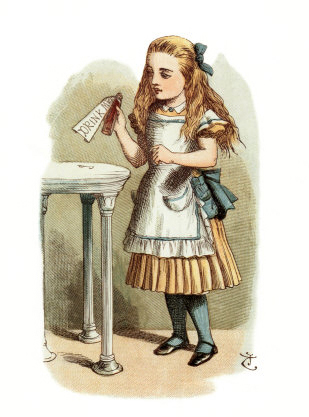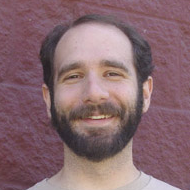
Alice opened the door and found that it led into a small passage, not much larger than a rat-hole: she knelt down and looked along the passage into the loveliest garden you ever saw. How she longed to get out of that dark hall, and wander about among those beds of bright flowers and those cool fountains, but she could not even get her head through the doorway; ‘and even if my head would go through,’ thought poor Alice, “it would be of very little use without my shoulders. Oh, how I wish I could shut up like a telescope! I think I could, if I only know how to begin.’ For, you see, so many out-of-the-way things had happened lately, that Alice had begun to think that very few things indeed were really impossible.
—Lewis Carroll, Alice’s Adventures through the Looking Glass
I will show you fear in a handful of dust.
—T. S. Eliot, The Wasteland
Sunday's Cosmos explored the world of the very small. And as Lewis Carroll warned us, very few things are impossible in the miniature world of the microscopic, the molecule, and the neutrino. Neil deGrasse Tyson shrinks down to explore a dew drop, observes a tardigrade and paramecium, and then shrinks further, to observe a chloroplast at work within a moss cell.
The animations of the workings of the cell were cartoonish industrial machinery, rather than the messy complexity of the real molecular workhorses within a cell. As Carl Zimmer recently observed in discussing new (and more accurate) animations, molecular activity within the cell is “barely constrained randomness.” The proteins within cells “are perpetually quivering. They pick up bits of energy from water molecules that bump into them, and they crash into other proteins and bounce off cell membranes.” In contrast to traditional animations of cells, and the orderly factory shown in Cosmos, Zimmer explains, “the parts of our cells don’t operate with the precise movements of the springs and gears of a clock. They flail blindly in the crowd. Our cells work almost in spite of themselves.” Here’s a telling animation of this frenzy:
This difference isn’t trivial. Creationists love to talk about “molecular machines,” and have even ripped off older animations that present the molecules ticking away like clockwork. The reality of what’s happening inside cells matters, and introducing that in the show would have offered a chance to explore a fascinating aspect of the world of molecules. As J. B. S. Haldane observed, “the Universe is not only queerer than we suppose, but queerer than we can suppose,” and that’s doubly true for the mesoscale world shaped by quantum effects and by the usual Newtonian physics, where Brownian motion dominates.
As Einstein explained in one of his early works, objects at the scale of molecules are constantly being bombarded by the random motion of neighboring molecules. To be a tardigrade wandering through the water, or a chlorophyll molecule in a plant’s chloroplast, would be something like living inside a lottery ball machine, constantly bombarded from random directions and pushed around by these unpredictable impacts. At the scale of people and planets and ping pong balls, these random impacts average out and we can ignore them. But in that intermediate realm Tyson took us through, they don’t, and everything is shaped by that busy randomness.
Tyson moved fairly quickly past that mesoworld and on down to the world of subatomic particles, finishing by considering the bizarre reality of neutrinos. These particles move at the speed of light, and unlike photons, they barely interact with matter. That means that neutrinos from exploding stars can fly out hours ahead of the light from the explosion (which gets trapped by the density of the matter). Neutrinos were proposed decades before they were discovered, as Wolfgang Pauli sought to balance the energetic accounts of decaying radioisotopes. Pauli proposed that neutrinos must exist to carry away the energy that seemed to disappear in that process. He acknowledged that this prediction couldn’t be tested, given the difficulty inherent in detecting such particles.
This exposes a critical and essential aspect of how science works. The ability to test predictions is at the center of most definitions of science, and in attempts to separate real science from pseudoscience, bad science, or nonscience (like creationism, homeopathy, astrology, etc.). But where would that leave neutrinos during the period when they were undetectable? Where does that leave the bulk of string theory today, when decisive tests of the theory are impossible with current technologies?
As I understand the importance of testing to science, the key is not that a claim is presently testable, or that it be testable independent of any number of auxiliary hypotheses (a problem which philosophers refer to as the Duhem-Quine Thesis). The key is that it at least be possible in principle to propose a way in which an idea could be wrong, even if such an experiment is not feasible at the moment. Pauli could understand how someone might detect neutrinos or rule out their existence, even if he didn’t have the ability at the time to perform that experiment.
By contrast, pseudoscientific ideas like creationism don’t propose meaningful tests. In creationism, the fundamental problem is that the system relies on an omnipotent creator, and in the end there’s nothing we could ever observe that (by definition) an omnipotent being couldn’t have done. And when people keep repeating claims long after they’ve been tested and found to be untrue, that’s also a hallmark of pseudoscience.
This ability to be wrong is critical to science. In the last minutes of this episode, Tyson explains how neutrinos may give us a glimpse of the earliest days of the universe:
The very thing that makes them almost impossible to detect is what allows neutrinos to sail through the curtain that conceals the beginning of time. Where are they now? They’re here, they’re there, everywhere throughout the universe. Neutrinos from creation are within you.
We don’t yet know how to see the picture they’d paint of those first moments after the Big Bang, but the fact that Tyson knows he might be wrong about that speculation is exactly what makes it so much more likely to be true than the speculations of creationists.

